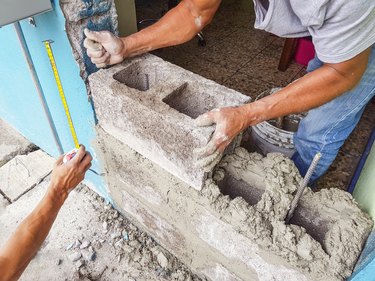Quck answer
To install tile on cinder block, follow these steps:
1. Prepare the cinder block surface by cleaning it thoroughly and removing any loose debris or paint.
2. Apply a layer of thin-set mortar to the cinder block using a trowel, ensuring an even coverage.
3. Place the tiles onto the mortar, pressing them firmly and using spacers to maintain consistent gaps between tiles.
4. Use a tile cutter or wet saw to cut tiles to fit around corners or edges.
5. Allow the mortar to dry completely, usually for 24-48 hours.
6. Apply grout onto the tiles, using a grout float to press it into the gaps.
7. Wipe off any excess grout with a damp sponge.
8. Let the grout cure for the recommended time, usually 24-72 hours.
9. Seal the grout to protect it from stains and moisture.
By following these steps, you can successfully install tile on cinder block and achieve a durable and attractive finish.
Cinder block walls can appear dull and unattractive, especially in a dim basement or as a backdrop in a cozy bedroom. Adding tiles to a cinder block wall not only enhances its appearance but also improves its water resistance and insulation properties. Properly preparing the cinder block wall before tiling is crucial for achieving a durable and visually appealing structure.

How to Install Tile on Cinder Block
Image Credit:
Kryssia Campos/Moment/GettyImages
Preparation of Cinder Block Wall
To begin, it is important to prepare the cinder block or concrete masonry unit block correctly. Any small cracks, large fissures, or chips should be addressed and repaired. Utilize a commercially made filler specifically designed for cinder or concrete blocks to create a smooth surface that will allow the tiles to adhere properly. Once the necessary repairs are complete, thoroughly clean the surface of the cinder block wall. Remove any dust, grout residue, or loose brick fragments to ensure that the new tiles adhere securely and do not loosen, crack, or deteriorate over time. If the concrete wall is level, tiles can be directly applied to the surface. Alternatively, a metal lath can be fastened to the wall using a scratch and brown coat of mortar, which is beneficial for uneven or damaged surfaces.
Preparation Methods
There are several methods for preparing a block wall for tiling, including direct mortar application, cement board installation, Kerdi board usage, and the use of a liquid membrane. Kerdi board building panels can be installed on the cinder block wall to create a pre-made flat and level surface. These panels are screwed onto the wall, providing both water resistance and thermal insulation. Various types of liquid membranes are available for preparing a cinder block wall. Liquid membranes are thick, waterproof materials that can be applied by brushing, spraying, or rolling onto the surface. They offer effective moisture protection and can be particularly useful for tiling basement walls. Direct mortar application involves mixing the mortar to a peanut butter-like consistency and applying it directly onto the cinder block wall using a trowel.
Tile Installation Process
To begin tiling, mark the middle of the wall with a chalk line as a guide for tile placement. Using a notched trowel, apply adhesive to the bottom of the cinder block wall. Apply enough adhesive to attach a few tiles at a time, ensuring that the adhesive remains moist and ready to receive the tiles. Gradually work your way up the wall, using cinder block spacers between each tile to ensure an even application. Additionally, use tile spacers along the floor and wall edges to keep the tiles securely in place. Once all the tiles are in position, allow the structure to dry for 24 hours before applying grout to fill the gaps between the tiles.
Improved Block Wall
Improved blocks, alternatively referred to as concrete blocks, are arranged in rows, which are levels with a half block to shift the row and form a stretcher bond. Cement mortar joints connect the individual blocks to form a strong connection. Horizontal steel reinforcements are inserted into the hollow blocks to enhance the wall’s structure, while other blocks contain vertical steel rods within their hollow cores. The vertical rods are utilized once the improved block wall reaches a certain height and begins to sway due to its own weight.


